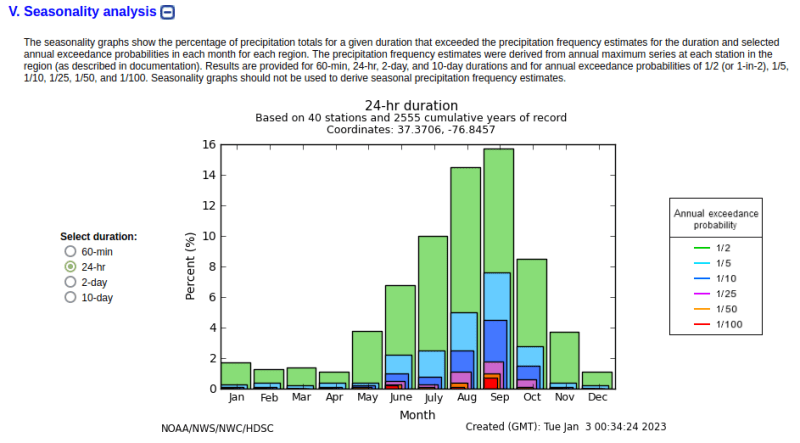I have long suspected that the Atlas 14 data for my community is potentially overestimated. Our City's stormwater ordinance requires 2-, 10-, & 100-yr, 24-hour detention.
I have taken 122 years worth of rainfall data from a NOAA recognized gauge in our community which provides 24-hour rainfall depth. I ran a daily study for all 122 years of data and found the following:
100-yr
-expected: 0 - 1
-occurred: 0
50-yr
-expected: 0 - 2
-occurred: 1
25-yr
-expected: 2 - 4
-occurred: 1
10-yr
-expected: 7 - 11
-occurred: 5
5-yr
-expected: 18 - 22
-occurred: 7
2-yr
-expected: 52 - 58
-occurred: 21

This seems to tell me that most of the 24-hour storm depths provided by Atlas 14 are higher than what we actually experience. I would like to use the 122 year data set to create my own recurrence intervals for a 24-hour storm.
I know there are quite a few limitations with a rain gauge of this type: user error, user consistency, missing data, assumes linear distribution or rainfall, doesn't not account for storms that bridge the "24-hour tracking period", etc., but I want to see what the recurrence intervals would be if I were to assume these errors did not exist.
After scouring the internet, I am looking for some guidance on how one would determine what the recurrence intervals are based on a daily data set.
I have taken 122 years worth of rainfall data from a NOAA recognized gauge in our community which provides 24-hour rainfall depth. I ran a daily study for all 122 years of data and found the following:
100-yr
-expected: 0 - 1
-occurred: 0
50-yr
-expected: 0 - 2
-occurred: 1
25-yr
-expected: 2 - 4
-occurred: 1
10-yr
-expected: 7 - 11
-occurred: 5
5-yr
-expected: 18 - 22
-occurred: 7
2-yr
-expected: 52 - 58
-occurred: 21

This seems to tell me that most of the 24-hour storm depths provided by Atlas 14 are higher than what we actually experience. I would like to use the 122 year data set to create my own recurrence intervals for a 24-hour storm.
I know there are quite a few limitations with a rain gauge of this type: user error, user consistency, missing data, assumes linear distribution or rainfall, doesn't not account for storms that bridge the "24-hour tracking period", etc., but I want to see what the recurrence intervals would be if I were to assume these errors did not exist.
After scouring the internet, I am looking for some guidance on how one would determine what the recurrence intervals are based on a daily data set.

